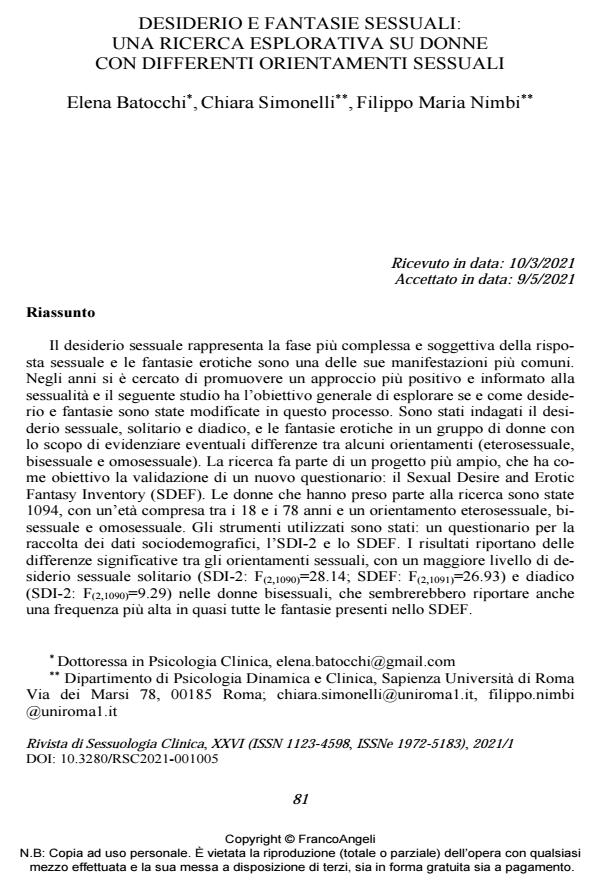Sexual desire and erotic fantasies, differences between women with different sex-ual orientations: an explorative study
Journal title RIVISTA DI SESSUOLOGIA CLINICA
Author/s Elena Batocchi, Chiara Simonelli, Filippo Maria Nimbi
Publishing Year 2021 Issue 2021/1
Language Italian Pages 21 P. 81-101 File size 242 KB
DOI 10.3280/RSC2021-001005
DOI is like a bar code for intellectual property: to have more infomation
click here
Below, you can see the article first page
If you want to buy this article in PDF format, you can do it, following the instructions to buy download credits

FrancoAngeli is member of Publishers International Linking Association, Inc (PILA), a not-for-profit association which run the CrossRef service enabling links to and from online scholarly content.
Sexual desire represents the most complex and subjective part of the sexual re-sponse and erotic fantasies are one of its common manifestation. Over the years, efforts have been made to promote a more positive and informed approach to sexuality and the following study has the general aim of exploring whether and how desire and fantasies have been changed in this process. The study inquires sexual desire, solitary and dyadic, and the erotic fantasies in a group of women with the aim of highlighting any differences between some sexual orientations (heterosexual, bisexual, and homosexual). Methods: participants were recruited by social network (Instagram, Facebook, etc.) and voluntarily agreed to fill in an online self-report questionnaire. The group is composed by 1094 women (mean age 27.86 ± 9.09 years) with three different sexual orientation, most of them are students and in a relationship. We used three different questionnaires: a socio-demographic questionnaire, the Sexual Desire Inventory-2 (SDI-2; Spector et al., 1996) to investigate levels of solitary and dyadic sexual desire, and the Sexual De-sire and Erotic Fantasy Inventory (SDEF) to investigate levels of solitary and dy-adic sexual desire and the erotic fantasies. Results: bisexual women report a higher level of solitary sexual desire (SDI-2: F(2,1090)=28.14; SDEF: F(2,1091)=26.93) and dy-adic sexual desire (SDI-2: F(2,1090)=9.29). They also report a higher frequency in al-most all erotic fantasies presented by SDEF, For example, in BDSM fantasies (Bondage ‒ Domination/Discipline ‒ Submission/Sadism ‒ Masochism) such as "being handcuffed, bound and/or gagged" (F(2,1994)=16.821), "being hit (spanked, slapped etc.)" (F(2,1994)=15.407) and "being dominated/submissive" (F(2,1994)=18.934) bisexual women report a higher frequency, as well as in fantasy "having sexual intercourse with two people" (F(2,1994)=44.180). The results highlight a significative difference between the three groups in the solitary sexual desire with a higher level in bisexual women. In the dyadic sexual desire levels, there is a dif-ference only between bisexual and heterosexual women. From the analysis of the erotic fantasies, it emerged that bisexual women report a higher frequency in almost all the 120 fantasies on the SDEF list. The results show that women’s fantasies tend to be more personal, with imaginary partners they are in relationship with or know about. This study can be a valuable springboard for future research in the field of erotic fantasies, where women are even less taken into consideration.
Keywords: sexual desire, erotic fantasies, women, bisexuality, homosexuality, SDEF.
Elena Batocchi, Chiara Simonelli, Filippo Maria Nimbi, Desiderio e fantasie sessuali: una ricerca esplorativa su donne con differenti orientamenti sessuali in "RIVISTA DI SESSUOLOGIA CLINICA" 1/2021, pp 81-101, DOI: 10.3280/RSC2021-001005